Physical, Thermal, and Antibacterial Effects of Active Essential Oils with Potential for Biomedical Applications Loaded onto Cellulose Acetate/Polycaprolactone Wet-Spun Microfibers
Abstract
1. Introduction
2. Materials and Methods
2.1. Materials
2.2. Agar-Well Diffusion Assay
2.3. Minimum Inhibitory Concentrations (MICs)
2.4. Cell Wall Disruption: Scanning Electron Microscopy (SEM) Observations
2.5. Wet-Spun Fiber Production and EO Immobilization
2.6. Fiber Characterization
2.6.1. Morphology: Brightfield Microscopy
2.6.2. Chemical Composition: Attenuated Total Reflectance with Fourier-Transform Infrared Spectroscopy (ATR-FTIR)
2.6.3. Thermal Stability: Thermal Gravimetric Analysis (TGA)
2.7. Time-Kill Kinetics
2.8. Membrane Permeability
3. Results and Discussion
3.1. Agar-Well Diffusion
3.2. MICs
3.3. Cell Wall Disruption
3.4. Wet-Spun Fibers Modification and Characterization
3.4.1. EO Loading Efficiency
3.4.2. Morphology
3.4.3. Chemical Composition
3.4.4. Thermal Stability
3.5. Time-Kill Kinetics
3.6. Cell Membrane Permeability
4. Conclusions
Supplementary Materials
Author Contributions
Funding
Acknowledgments
Conflicts of Interest
References
- Tavares, T.D.; Antunes, J.C.; Ferreira, F.; Felgueiras, H.P. Biofunctionalization of natural fiber-reinforced biocomposites for biomedical applications. Biomolecules 2020, 10, 148. [Google Scholar] [CrossRef] [PubMed]
- MacLean, R.C.; Millan, S.A. The evolution of antibiotic resistance. Science 2019, 365, 1082–1083. [Google Scholar] [CrossRef] [PubMed]
- Willyard, C. The drug-resistant bacteria that pose the greatest health threats. Nature 2017, 543, 15. [Google Scholar] [CrossRef] [PubMed]
- Yuan, H.; Ma, Q.; Ye, L.; Piao, G. The traditional medicine and modern medicine from natural products. Molecules 2016, 21, 559. [Google Scholar] [CrossRef] [PubMed]
- Tavares, T.D.; Antunes, J.C.; Padrão, J.; Ribeiro, A.I.; Zille, A.; Amorim, M.T.P.; Ferreira, F.; Felgueiras, H.P. Activity of specialized biomolecules against Gram-positive and Gram-negative bacteria. Antibiotics 2020, 9, 314. [Google Scholar] [CrossRef]
- Omonijo, F.A.; Ni, L.; Gong, J.; Wang, Q.; Lahaye, L.; Yang, C. Essential oils as alternatives to antibiotics in swine production. Anim. Nutr. 2018, 4, 126–136. [Google Scholar] [CrossRef]
- Miranda, C.S.; Ribeiro, A.R.; Homem, N.C.; Felgueiras, H.P. Spun biotextiles in tissue engineering and biomolecules delivery systems. Antibiotics 2020, 9, 174. [Google Scholar] [CrossRef]
- Felgueiras, H.P.; Amorim, M.T.P. Functionalization of electrospun polymeric wound dressings with antimicrobial peptides. Colloids Surf. B Biointerfaces 2017, 156, 133–148. [Google Scholar] [CrossRef]
- Felgueiras, H.P.; Tavares, T.; Amorim, M. Biodegradable, spun nanocomposite polymeric fibrous dressings loaded with bioactive biomolecules for an effective wound healing: A review. In IOP Conference Series: Materials Science and Engineering; IOP Publishing: Bangkok, Thailand, 2019. [Google Scholar]
- Puppi, D.; Dinucci, D.; Bartoli, C.; Mota, C.; Migone, C.; Dini, F.; Barsotti, G.; Carlucci, F.; Chiellini, F. Development of 3D wet-spun polymeric scaffolds loaded with antimicrobial agents for bone engineering. J. Bioact. Compat. Polym. 2011, 26, 478–492. [Google Scholar] [CrossRef]
- Tuzlakoglu, K.; Reis, R. Chitosan-based scaffolds in orthopedic applications. In Natural-Based Polymers for Biomedical Applications; Elsevier: Amsterdam, The Netherlands, 2008; pp. 357–373. [Google Scholar]
- Puppi, D.; Chiellini, F. Wet-spinning of biomedical polymers: From single-fibre production to additive manufacturing of three-dimensional scaffolds. Polym. Int. 2017, 66, 1690–1696. [Google Scholar] [CrossRef]
- Teixeira, M.A.; Paiva, M.C.; Amorim, M.T.P. Electrospun nanocomposites containing cellulose and its derivatives modified with specialized biomolecules for an enhanced wound healing. Nanomaterials 2020, 10, 557. [Google Scholar] [CrossRef] [PubMed]
- Felgueiras, H.P.; Teixeira, M.A.; Tavares, T.D.; Homem, N.C.; Zille, A.; Amorim, M.T.P. Antimicrobial action and clotting time of thin, hydrated poly (vinyl alcohol)/cellulose acetate films functionalized with LL37 for prospective wound-healing applications. J. Appl. Polym. Sci. 2020, 137, 48626. [Google Scholar] [CrossRef]
- Homem, N.C.; Amorim, M.T.P. Synthesis of cellulose acetate using as raw material textile wastes. Mater. Today Proceed. 2020. [Google Scholar] [CrossRef]
- Silva, M.; Rocha, C.V.; Gallo, J.; Felgueiras, H.; de Amorim, M.P. Porous composites based on cellulose acetate and alfa-hematite with optical and antimicrobial properties. Carbohydr. Polym. 2020, 241, 116362. [Google Scholar] [CrossRef] [PubMed]
- Khoshnevisan, K.; Maleki, H.; Samadian, H.; Doostan, M.; Khorramizadeh, M.R. Antibacterial and antioxidant assessment of cellulose acetate/polycaprolactone nanofibrous mats impregnated with propolis. Int. J. Biol. Macromol. 2019, 140, 1260–1268. [Google Scholar] [CrossRef] [PubMed]
- Malikmammadov, E.; Tanir, T.E.; Kiziltay, A.; Hasirci, V.; Hasirci, N. PCL and PCL-based materials in biomedical applications. J. Biomater. Sci. Polym. Ed. 2018, 29, 863–893. [Google Scholar] [CrossRef] [PubMed]
- Wiegand, I.; Hilpert, K.; Hancock, R.E. Agar and broth dilution methods to determine the minimal inhibitory concentration (MIC) of antimicrobial substances. Nat. Protoc. 2008, 3, 163. [Google Scholar] [CrossRef]
- European Committee for Antimicrobial Susceptibility Testing (EUCAST) of the European Society of Clinical Microbiology and Infectious Diseases (ESCMID). Determination of minimum inhibitory concentrations (MICs) of antibacterial agents by broth dilution. Clin. Microbiol. Infect. 2003, 9, ix–xv. [Google Scholar] [CrossRef]
- Kong, M.; Chen, X.G.; Liu, C.S.; Liu, C.G.; Meng, X.H. Antibacterial mechanism of chitosan microspheres in a solid dispersing system against E. coli. Colloids Surf. B Biointerfaces 2008, 65, 197–202. [Google Scholar] [CrossRef]
- Nikaido, H. Porins and specific diffusion channels in bacterial outer membranes. J. Biol. Chem. 1994, 269, 3905–3908. [Google Scholar]
- Rota, M.C.; Herrera, A.; Martínez, R.M.; Sotomayor, J.A.; Jordán, M.J. Antimicrobial activity and chemical composition of Thymus vulgaris, Thymus zygis and Thymus hyemalis essential oils. Food Control 2008, 19, 681–687. [Google Scholar] [CrossRef]
- Nairi, V.; Medda, L.; Monduzzi, M.; Salis, A. Adsorption and release of ampicillin antibiotic from ordered mesoporous silica. J. Colloid Interface Sci. 2017, 497, 217–225. [Google Scholar] [CrossRef] [PubMed]
- Lv, F.; Liang, H.; Yuan, Q.; Li, C. In vitro antimicrobial effects and mechanism of action of selected plant essential oil combinations against four food-related microorganisms. Food Res. Int. 2011, 44, 3057–3064. [Google Scholar] [CrossRef]
- Coelho, D.; Sampaio, A.; Silva, C.J.; Felgueiras, H.P.; Amorim, M.T.P.; Zille, A. Antibacterial electrospun poly (vinyl alcohol)/enzymatic synthesized poly (catechol) nanofibrous midlayer membrane for ultrafiltration. ACS Appl. Mater. Interfaces 2017, 9, 33107–33118. [Google Scholar] [CrossRef] [PubMed]
- Kumar, S.; Kumar, A.; Kumar, R. Himalayan (Himachal region) cedar wood (Cedrus deodara: Pinaceae) essential oil, its processing, ingredients and uses: A review. J. Pharmacogn. Phytochem. 2019, 8, 2228–2238. [Google Scholar]
- Kumari, V.; Sangal, A. Study of antimicrobial activity of star anise loaded poly (DL-lactide-co-glycolide) nanoparticles. Res. J. Pharm. Technol. 2019, 12, 499–507. [Google Scholar] [CrossRef]
- Hammer, K.A.; Carson, C.F.; Riley, T.V. Antimicrobial activity of essential oils and other plant extracts. J. Appl. Microbiol. 1999, 86, 985–990. [Google Scholar] [CrossRef]
- Sutrisno, S.; Retnosari, R.; Asmaningrum, H.P. Profile of the Indonesian Essential Oil from Melaleuca cajuputi. In Proceedings of the Seminar Nasional Kimia-National Seminar on Chemistry (SNK 2018), Surabaya, Indonesia, 22 September 2018; Atlantis Press: Surabaya, Indonesia.
- Carson, C.F.; Hammer, K.A.; Riley, T.V. Melaleuca alternifolia (Tea Tree) oil: A review of antimicrobial and other medicinal properties. Clin. Microbiol. Rev. 2006, 19, 50–62. [Google Scholar] [CrossRef]
- Marchese, A.; Barbieri, R.; Coppo, E.; Orhan, I.E.; Daglia, M.; Nabavi, S.F.; Izadi, M.; Abdollahi, M.; Nabavi, S.M.; Ajami, M. Antimicrobial activity of eugenol and essential oils containing eugenol: A mechanistic viewpoint. Crit. Rev. Microbiol. 2017, 43, 668–689. [Google Scholar] [CrossRef]
- Paranagama, P.; Wimalasena, S.; Jayatilake, G.; Jayawardena, A.; Senanayake, U.; Mubarak, A. A comparison of essential oil constituents of bark, leaf, root and fruit of cinnamon (Cinnamomum zeylanicum Blum) grown in Sri Lanka. J. Natl. Sci. Found. Sri 2001, 29, 147–153. [Google Scholar] [CrossRef]
- Chaieb, K.; Hajlaoui, H.; Zmantar, T.; Kahla-Nakbi, A.B.; Rouabhia, M.; Mahdouani, K.; Bakhrouf, A. The chemical composition and biological activity of clove essential oil, Eugenia caryophyllata (Syzigium aromaticum L.). Myrtaceae): A short review. Phytother. Res. 2007, 21, 501–506. [Google Scholar]
- Burt, S. Essential oils: Their antibacterial properties and potential applications in foods—A review. Int. J. Food Microbiol. 2004, 94, 223–253. [Google Scholar] [CrossRef] [PubMed]
- Zapun, A.; Vernet, T.; Pinho, M.G. The different shapes of cocci. FEMS Microbiol. Rev. 2008, 32, 345–360. [Google Scholar] [CrossRef]
- Nanninga, N. Morphogenesis of escherichia coli. Microbiol. Mol. Biol. Rev. 1998, 62, 110–129. [Google Scholar] [CrossRef] [PubMed]
- Nazzaro, F.; Fratianni, F.; de Martino, L.; Coppola, R.; de Feo, V. Effect of essential oils on pathogenic bacteria. Pharmaceuticals 2013, 6, 1451–1474. [Google Scholar] [CrossRef] [PubMed]
- Cansian, R.; Vanin, A.; Orlando, T.; Piazza, S.; Puton, B.; Cardoso, R.; Gonçalves, I.; Honaiser, T.; Paroul, N.; Oliveira, D. Toxicity of clove essential oil and its ester eugenyl acetate against Artemia salina. Braz. J. Biol. 2017, 77, 155–161. [Google Scholar] [CrossRef]
- Elzein, T.; Nasser-Eddine, M.; Delaite, C.; Bistac, S.; Dumas, P. FTIR study of polycaprolactone chain organization at interfaces. J. Colloid Interface Sci. 2004, 273, 381–387. [Google Scholar] [CrossRef]
- Matwijczuk, A.; Oniszczuk, T.; Matwijczuk, A.; Chruściel, E.; Kocira, A.; Niemczynowicz, A.; Wójtowicz, A.; Combrzyński, M.; Wiącek, D. Use of FTIR spectroscopy and chemometrics with respect to storage conditions of moldavian dragonhead oil. Sustainability 2019, 11, 6414. [Google Scholar] [CrossRef]
- Ren, X.; Yue, S.; Xiang, H.; Xie, M. Inclusion complexes of eucalyptus essential oil with β-cyclodextrin: PREPARATION, characterization and controlled release. J. Porous Mater. 2018, 25, 1577–1586. [Google Scholar] [CrossRef]
- Rogowska, A.; Rafińska, K.; Pomastowski, P.; Walczak, J.; Railean-Plugaru, V.; Buszewska-Forajta, M.; Buszewski, B. Silver nanoparticles functionalized with ampicillin. Electrophoresis 2017, 38, 2757–2764. [Google Scholar] [CrossRef]
- Li, Y.-q.; Kong, D.-x.; Wu, H. Analysis and evaluation of essential oil components of cinnamon barks using GC–MS and FTIR spectroscopy. Ind. Crops. Prod. 2013, 41, 269–278. [Google Scholar] [CrossRef]
- Rodríguez, J.D.W.; Peyron, S.; Rigou, P.; Chalier, P. Rapid quantification of clove (Syzygium aromaticum) and spearmint (Mentha spicata) essential oils encapsulated in a complex organic matrix using an ATR-FTIR spectroscopic method. PLoS ONE 2018, 13, e0207401. [Google Scholar] [CrossRef]
- Niculescu, O.; Albu, L.; Loghin, M.C.; Gaidau, C.; Miu, L.; Coara, G. Selection and characterization of some essential oils for the treatment of medical furs. Rev. Chim. 2019, 70, 498–502. [Google Scholar] [CrossRef]
- Wen, P.; Zhu, D.-H.; Wu, H.; Zong, M.-H.; Jing, Y.-R.; Han, S.-Y. Encapsulation of cinnamon essential oil in electrospun nanofibrous film for active food packaging. Food Control 2016, 59, 366–376. [Google Scholar] [CrossRef]
- Qin, Y.; Li, W.; Liu, D.; Yuan, M.; Li, L. Development of active packaging film made from poly (lactic acid) incorporated essential oil. Progr. Org. Coat. 2017, 103, 76–82. [Google Scholar] [CrossRef]
- Wang, G.; Yang, S.; Wei, Z.; Dong, X.; Wang, H.; Qi, M. Facile preparation of poly (ε-caprolactone)/Fe 3 O 4@ graphene oxide superparamagnetic nanocomposites. Polym. Bull. 2013, 70, 2359–2371. [Google Scholar] [CrossRef]
- May, J.; Chan, C.H.; King, A.; Williams, L.; French, G.L. Time-kill studies of tea tree oils on clinical isolates. J. Antimicrob. Chemother. 2000, 45, 639–643. [Google Scholar] [CrossRef]
- Mutlu-Ingok, A.; Karbancioglu-Guler, F. Cardamom, cumin, and dill weed essential oils: Chemical compositions, antimicrobial activities, and mechanisms of action against Campylobacter spp. Molecules 2017, 22, 1191. [Google Scholar] [CrossRef]
- Diao, W.-R.; Hu, Q.-P.; Zhang, H.; Xu, J.-G. Chemical composition, antibacterial activity and mechanism of action of essential oil from seeds of fennel (Foeniculum vulgare Mill.). Food Control 2014, 35, 109–116. [Google Scholar] [CrossRef]
- Zhang, Y.; Liu, X.; Wang, Y.; Jiang, P.; Quek, S. Antibacterial activity and mechanism of cinnamon essential oil against Escherichia coli and Staphylococcus aureus. Food Control 2016, 59, 282–289. [Google Scholar] [CrossRef]
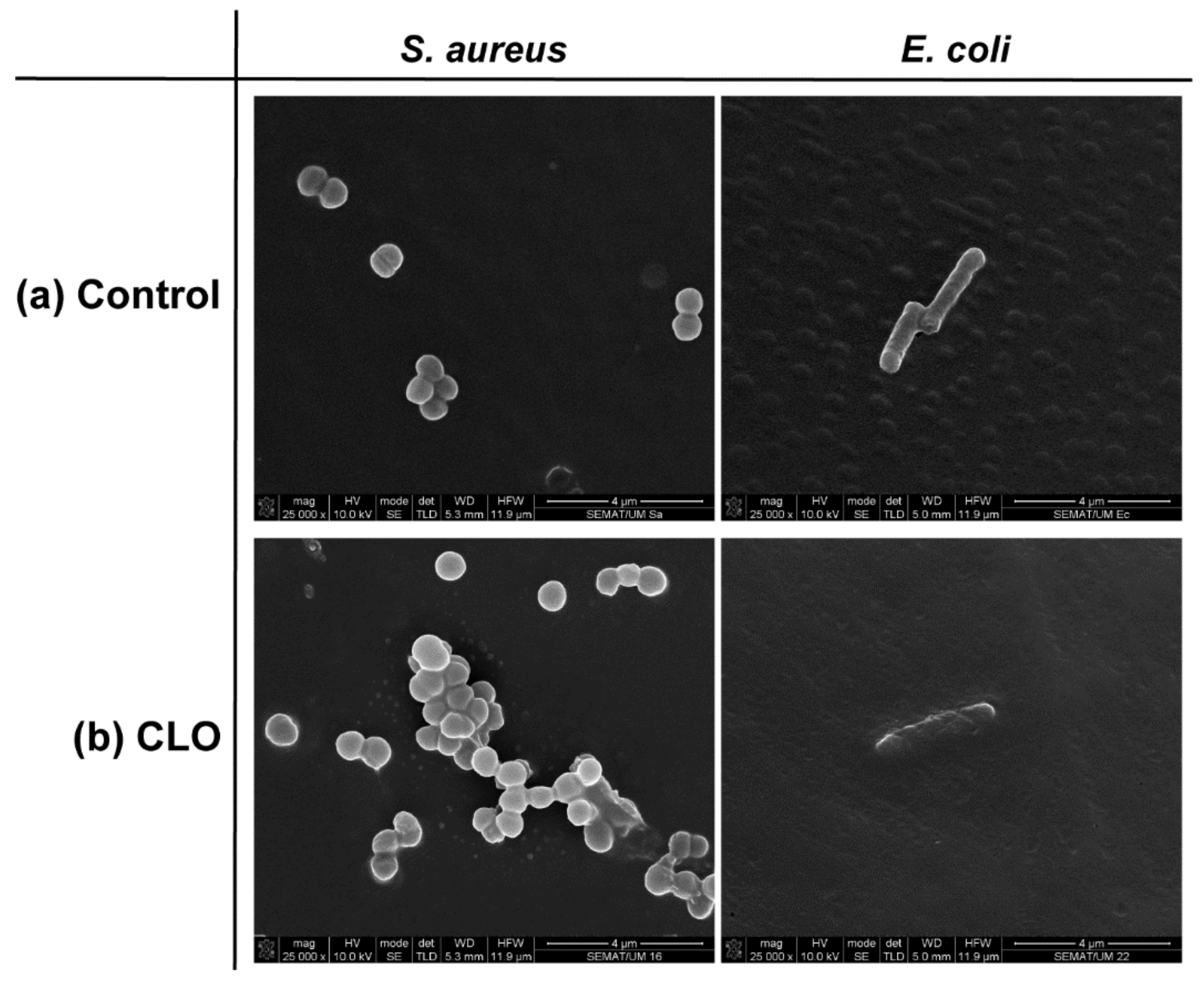
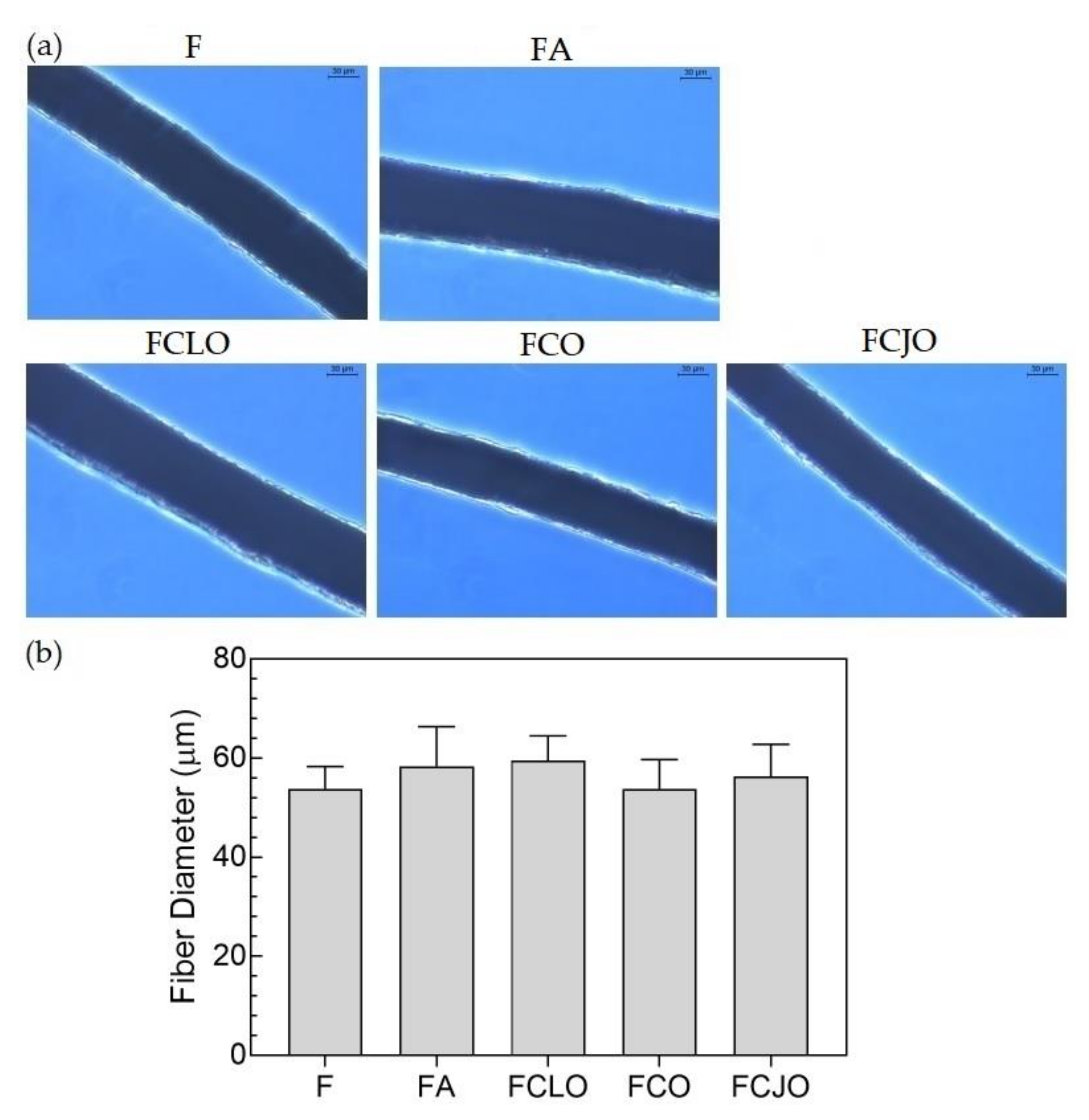
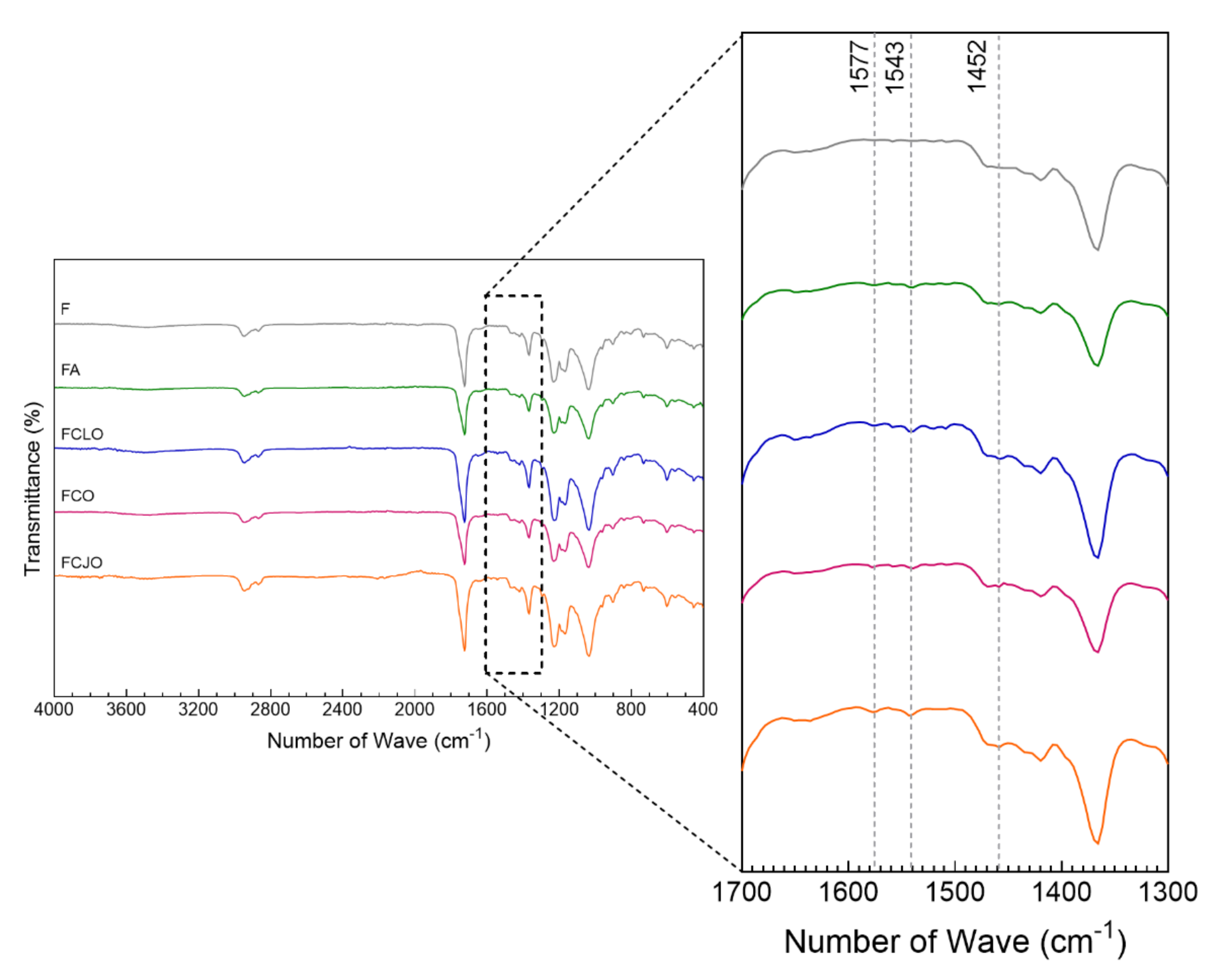
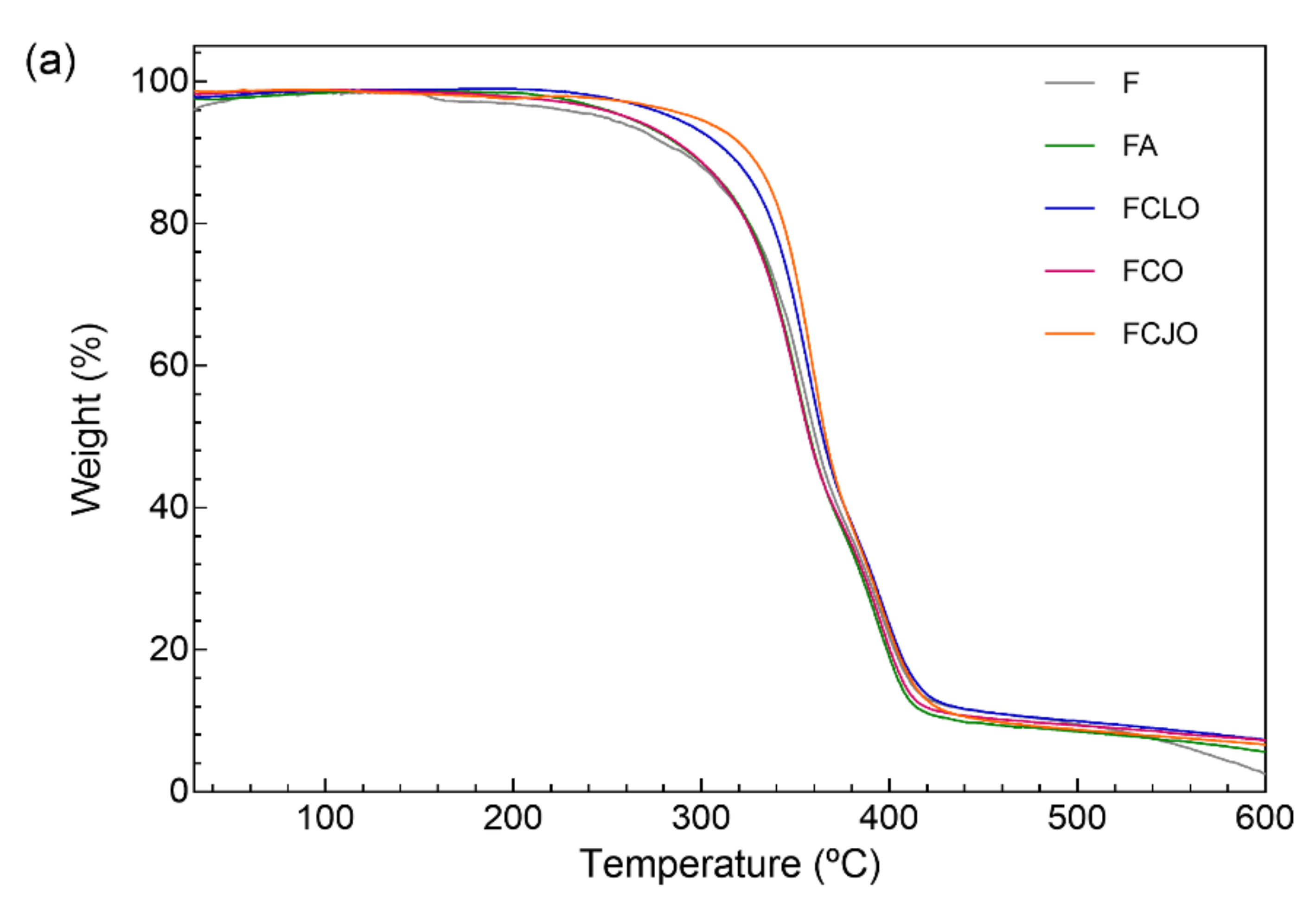
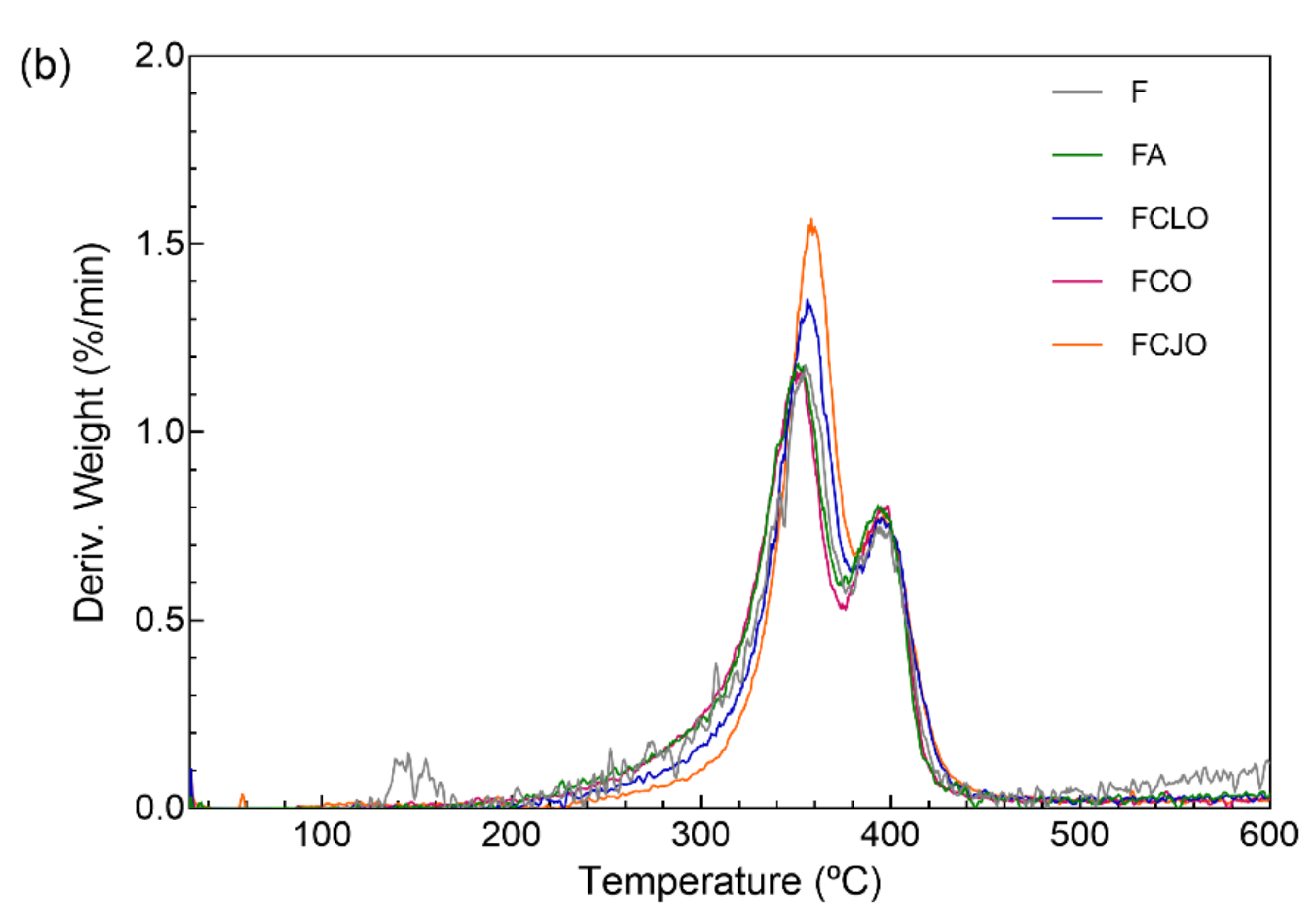

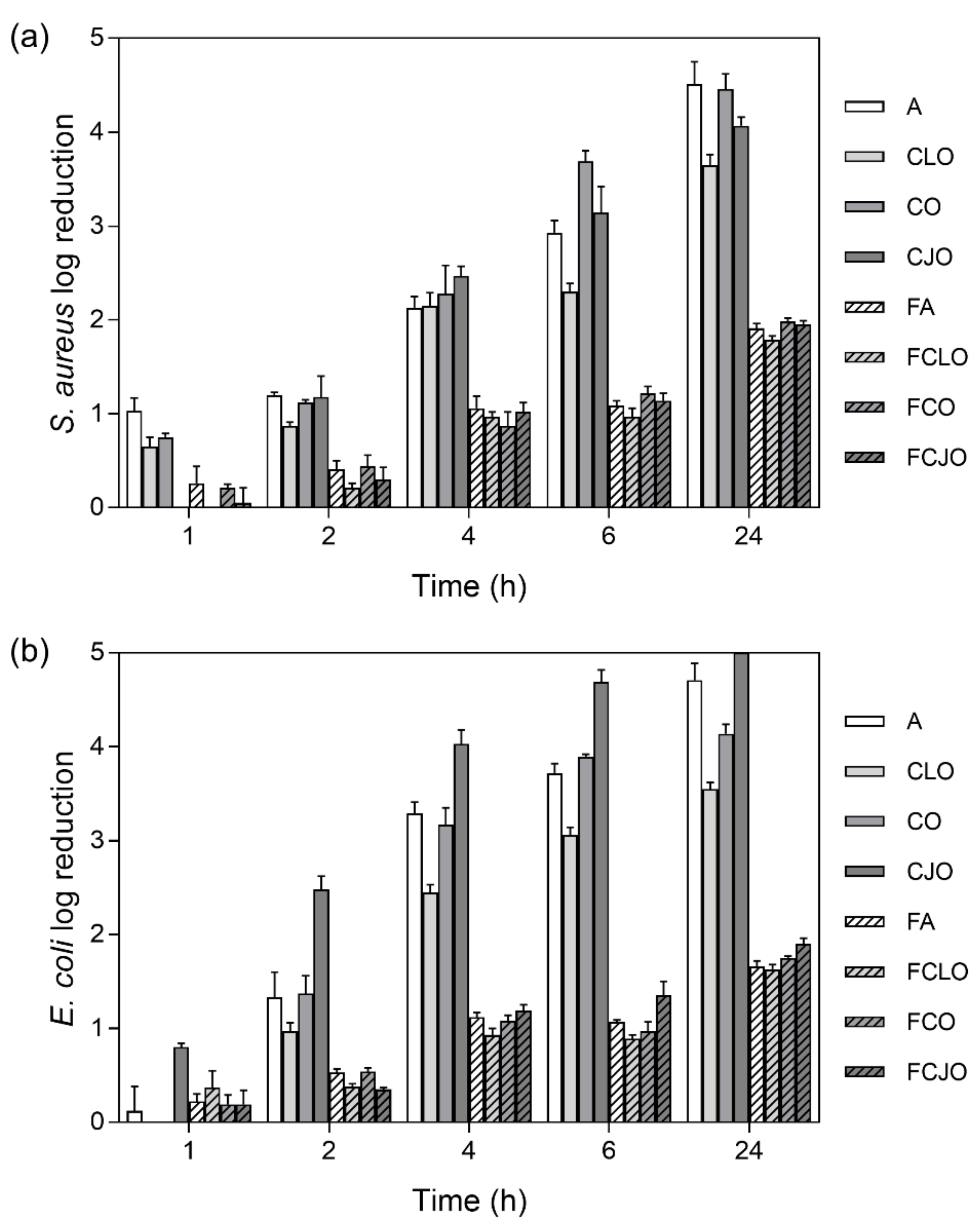
| EO | Abbreviation | Origin | Density (g/cm3) |
|---|---|---|---|
| Amyris | AO | Amyris balsamifera | 0.957 |
| Cajeput | CJO | Melaleuca leucadendron | 0.911 |
| Cinnamon leaf | CLO | Cinnamomum zeylanicum | 1.049 |
| Citronella | CIO | Cymbopogon winterianus | 0.882 |
| Clove | CO | Eugenia caryophyllus | 1.056 |
| Eucalyptus | ELO | Eucalyptus globulus L. | 1.465 |
| Frankincense | FO | Boswellia carterii | 0.857 |
| Geranium | GO | Pelargonium graveolens | 0.895 |
| Himalayan cedar | HCO | Cedrus deodara Loud. | 0.935 |
| Lavandin | LO | Lavandula hybrida | 0.889 |
| Lemongrass | LGO | Cymbopogon flexuosus | 0.890 |
| Niaouli | NO | Melaleuca viridiflora | 0.913 |
| Orchid | OO | Orchidaceae | 0.856 |
| Palmarosa | PMO | Cymbopogon martinii var.motia | 0.884 |
| Patchouli | PTO | Pogostemon patchouli | 0.960 |
| Rosemary | RO | Rosmarinus officinalis | 0.900 |
| Sage | SO | Salvia officinalis | 0.915 |
| Star anise | SAO | Illicium verum | 0.981 |
| Tea tree oil | TTO | Melaleuca alternifolia | 0.895 |
| Wintergreen | WO | Gaultheria procumbens | 1.182 |
| Antimicrobial Agents | ZoI Diameter (mm) | Antimicrobial Agents | ZoI Diameter (mm) |
|---|---|---|---|
| S. aureus | E. coli | ||
| A | 28.67 ± 0.58 | A | 23.50 ± 0.50 |
| RO | 18.33 ± 2.08 | CJO | 21.33 ± 0.58 |
| FO | 17.83 ± 0.76 | TTO | 14.67 ± 2.08 |
| ELO | 16.67 ± 1.15 | SO | 13.00 ± 2.65 |
| NO | 16.33 ± 1.53 | CLO | 12.83 ± 0.76 |
| CJO | 15.67 ± 1.53 | NO | 12.67 ± 1.15 |
| CO | 15.00 ± 1.00 | CO | 12.33 ± 1.58 |
| SO | 14.67 ± 0.58 | RO | 11.33 ± 3.21 |
| PTO | 13.50 ± 0.50 | LGO | 10.67 ± 0.58 |
| TTO | 13.33 ± 1.53 | ELO | 10.00 ± 1.00 |
| CLO | 12.67 ± 0.58 | FO | 9.83 ± 1.26 |
| LGO | 12.17 ± 0.29 | LO | 9.00 ± 1.00 |
| PMO | 11.33 ± 0.58 | PMO | 8.00 ± 0.50 |
| LO | 11.00 ± 1.00 | OO | 7.33 ± 0.58 |
| GO | 9.33 ± 0.58 | GO | 6.83 ± 0.29 |
| CIO | 9.17 ± 0.29 | AO | - |
| OO | 8.83 ± 0.29 | CIO | - |
| AO | 8.33 ± 0.58 | HCO | - |
| HCO | - | PTO | - |
| SAO | - | SAO | - |
| WO | - | WO | - |
| Antimicrobial Agents | MICs (mg/mL) | Antimicrobial Agents | MICs (mg/mL) |
|---|---|---|---|
| S. aureus | E. coli | ||
| CLO | 0.82 | CLO | 0.82 |
| CO | 0.83 | CO | 0.83 |
| CJO | 22.38 | CJO | 11.19 |
| TTO | 22.38 | TTO | 11.39 |
| A | 0.03 | A | 0.03 |
| ELO | 36.63 | SO | 45.75 |
| LGO | 44.50 | GO | 89.50 |
| NO | 45.65 | LGO | 89.00 |
| PTO | 48.00 | NO | 91.30 |
| CIO | 88.20 | ELO | 146.50 |
| LO | 88.90 | RO | 180.02 |
| RO | 90.01 | OO | 342.40 |
| SO | 91.50 | FO | 342.80 |
| OO | 171.20 | PMO | 353.60 |
| PMO | 176.80 | CIO | >352.80 |
| AO | 191.40 | LO | >355.60 |
| WO | 236.40 | HCO | >374.00 |
| GO | 358.00 | AO | >382.80 |
| FO | >342.80 | PTO | >384.00 |
| HCO | >374.00 | SAO | >392.40 |
| SAO | >392.40 | WO | >472.80 |
| REC (%) | ||||||||||
|---|---|---|---|---|---|---|---|---|---|---|
| Bacteria | C | A | CLO | CO | CJO | F | FA | FCLO | FCO | FCJO |
| S. aureus | −0.49 | 19.10 | 9.81 | 19.83 | 20.41 | −0.29 | 1.96 | 1.10 | 3.19 | 8.34 |
| E. coli | −1.01 | 15.50 | 6.08 | 12.69 | 25.09 | −1.32 | 0.75 | 0.67 | 1.69 | 4.49 |
© 2020 by the authors. Licensee MDPI, Basel, Switzerland. This article is an open access article distributed under the terms and conditions of the Creative Commons Attribution (CC BY) license (http://creativecommons.org/licenses/by/4.0/).
Share and Cite
Felgueiras, H.P.; Homem, N.C.; Teixeira, M.A.; Ribeiro, A.R.M.; Antunes, J.C.; Amorim, M.T.P. Physical, Thermal, and Antibacterial Effects of Active Essential Oils with Potential for Biomedical Applications Loaded onto Cellulose Acetate/Polycaprolactone Wet-Spun Microfibers. Biomolecules 2020, 10, 1129. https://doi.org/10.3390/biom10081129
Felgueiras HP, Homem NC, Teixeira MA, Ribeiro ARM, Antunes JC, Amorim MTP. Physical, Thermal, and Antibacterial Effects of Active Essential Oils with Potential for Biomedical Applications Loaded onto Cellulose Acetate/Polycaprolactone Wet-Spun Microfibers. Biomolecules. 2020; 10(8):1129. https://doi.org/10.3390/biom10081129
Chicago/Turabian StyleFelgueiras, Helena P., Natália C. Homem, Marta A. Teixeira, Ana R. M. Ribeiro, Joana C. Antunes, and Maria Teresa P. Amorim. 2020. "Physical, Thermal, and Antibacterial Effects of Active Essential Oils with Potential for Biomedical Applications Loaded onto Cellulose Acetate/Polycaprolactone Wet-Spun Microfibers" Biomolecules 10, no. 8: 1129. https://doi.org/10.3390/biom10081129
APA StyleFelgueiras, H. P., Homem, N. C., Teixeira, M. A., Ribeiro, A. R. M., Antunes, J. C., & Amorim, M. T. P. (2020). Physical, Thermal, and Antibacterial Effects of Active Essential Oils with Potential for Biomedical Applications Loaded onto Cellulose Acetate/Polycaprolactone Wet-Spun Microfibers. Biomolecules, 10(8), 1129. https://doi.org/10.3390/biom10081129









